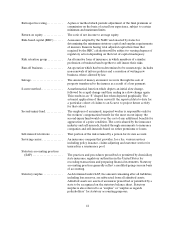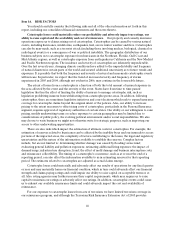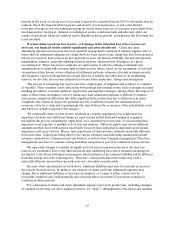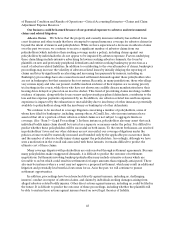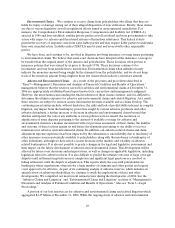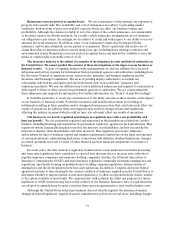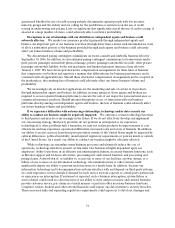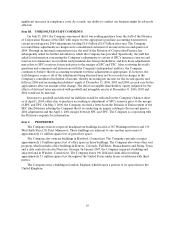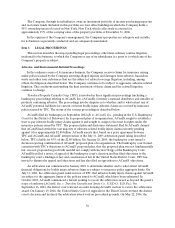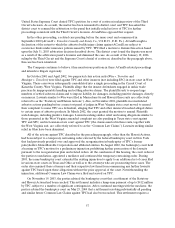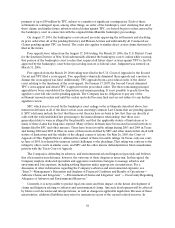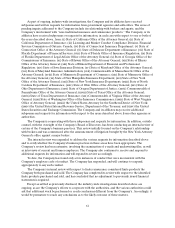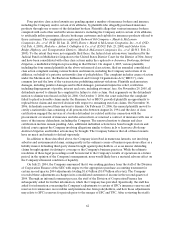Travelers 2006 Annual Report Download - page 65
Download and view the complete annual report
Please find page 65 of the 2006 Travelers annual report below. You can navigate through the pages in the report by either clicking on the pages listed below, or by using the keyword search tool below to find specific information within the annual report.53
•agent, broker and client relationships,
•premiums charged, contract terms and conditions, products andservices offered (including the
ability to design customized programs),
•speed of claims payment,
•reputation, experience and qualifications of employees,
•local presence and
•our ability to keep pace relative to competitors with changes in technology and information systems.
We may have difficulty in continuing to compete successfully on any of these bases in the future. If
competition limits our ability to write newbusiness at adequate rates, our results of operations will be
adversely affected. See “Item 1—Business—Competition.”
Theinability of our insurancesubsidiaries to pay dividends to usin sufficient amounts wouldharm
our ability to meet our obligations and to pay future dividends.We are a holding company and rely in
partondividends from our insurance subsidiaries to meet our obligations for payment of interest and
principal on outstanding debt obligations and to pay dividends to shareholders and corporate expenses.
The ability of our insurance subsidiaries to pay dividends to us in the future will depend on their statutory
surplus, earnings and regulatory restrictions.
We and our insurance subsidiaries are subject to regulation by some states as an insuranceholding
company system. This regulation generally provides that transactions among companies within the holding
company system must be fair and reasonable. Transfers of assets among affiliated companies, certain
dividend payments from insurance subsidiaries and certain material transactions between companies
within the system may require prior notice to, or prior approval by, state regulatory authorities. Our
insurancesubsidiaries are subject to various regulatory restrictions that limit the maximum amount of
dividends available to be paid to their parent without prior approval of insurance regulatory authorities.
The ability of our insurance subsidiaries to pay dividends to us also is restricted by regulations that set
standards of solvency that must be met and maintained, the nature of and limitation on investments, the
nature of and limitations ondividends to policyholders and shareholders, the nature and extent of required
participation in insurance guaranty funds and the involuntary assumption of hard-to-place orhigh-risk
insurance business, primarily in workers’ compensation insurance lines. The inability of our insurance
subsidiaries to pay dividends to us in an amount sufficient to meet our debt service obligations and other
cash requirements couldharm our ability to meet our obligations and to pay future dividends.
Assessments and other surcharges for guaranty funds, second-injury funds, catastrophe funds and
other mandatory pooling arrangements may reduce our profitability. Virtually all states require insurers
licensed to do business in their state to bear a portionof the loss suffered by some insureds as theresult of
impaired or insolvent insurance companies. Guaranty fund assessments have leveled off in the recent year
and, in certain states, have begun to decrease. These assessments may, however, increase in the future if
additional insolvencies occur. Many states also have laws that established second-injury funds toprovide
compensation to injured employees for aggravation of a prior condition or injury which are funded by
either assessments based on paid losses or premium surcharge mechanisms. In addition, as a condition to
the ability to conduct business in various states, our insurance subsidiaries must participate in mandatory
property and casualty shared-market mechanisms or pooling arrangements, which provide various types of
insurance coverage to individuals or other entities that otherwise are unable to purchase that coverage
from private insurers. The effect of these assessments and mandatory shared-market mechanisms or
changes in them could adversely affect profitability or limit our ability to growour business.
Lossor significant restriction of the use of credit scoringin the pricing and underwriting of Personal
Insurance products could reduce our future profitability. In Personal Insurance, we use credit scoring as
a factor in pricing decisions where allowed by state law. Some consumer groups and regulators have



